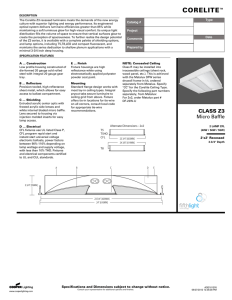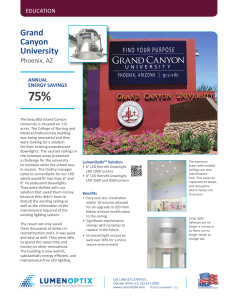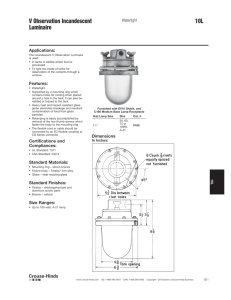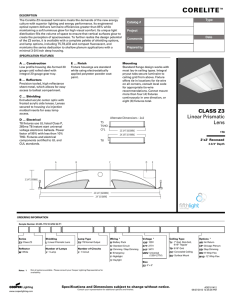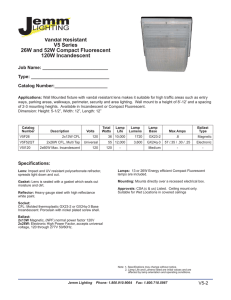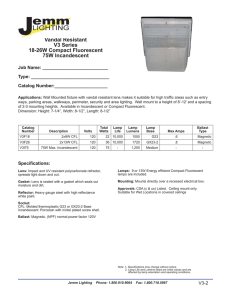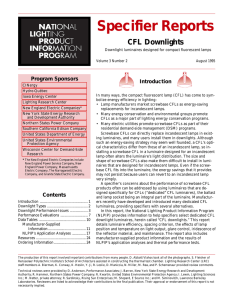Residential Recessed Downlights
advertisement
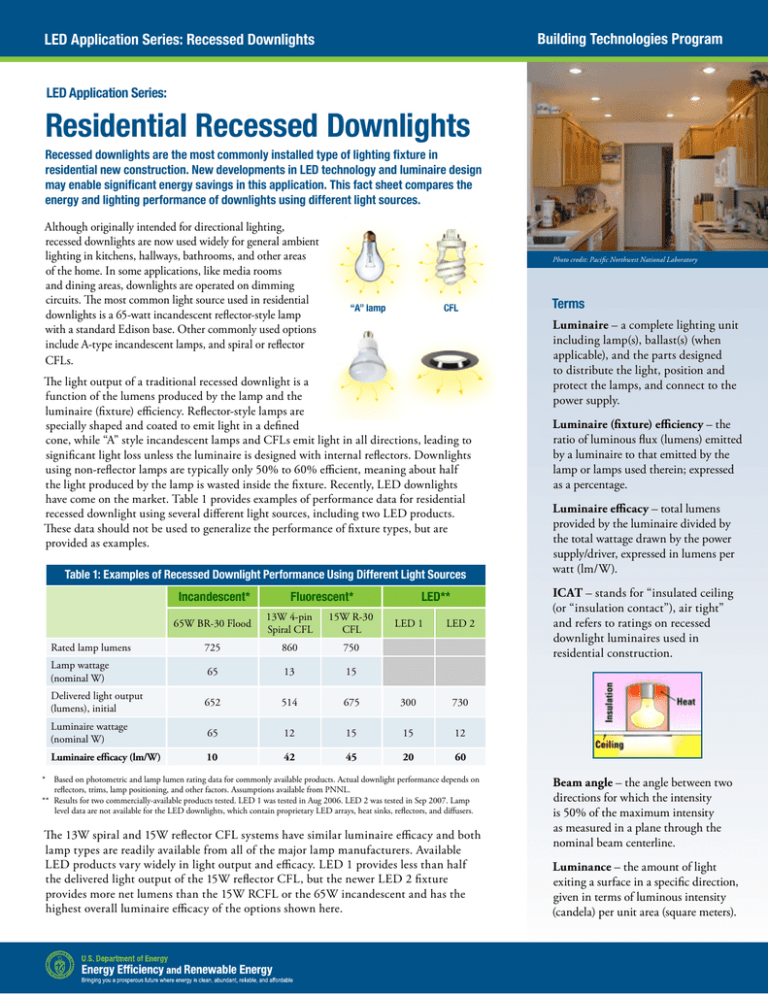
Building Technologies Program LED Application Series: Recessed Downlights LED Application Series: Residential Recessed Downlights Recessed downlights are the most commonly installed type of lighting fixture in residential new construction. New developments in LED technology and luminaire design may enable significant energy savings in this application. This fact sheet compares the energy and lighting performance of downlights using different light sources. Although originally intended for directional lighting, recessed downlights are now used widely for general ambient lighting in kitchens, hallways, bathrooms, and other areas of the home. In some applications, like media rooms and dining areas, downlights are operated on dimming circuits. The most common light source used in residential downlights is a 65-watt incandescent reflector-style lamp with a standard Edison base. Other commonly used options include A-type incandescent lamps, and spiral or reflector CFLs. Photo credit: Pacific Northwest National Laboratory CFL “A” lamp The light output of a traditional recessed downlight is a function of the lumens produced by the lamp and the Reflector LED luminaire (fixture) efficiency. Reflector-style lamps are specially shaped and coated to emit light in a defined cone, while “A” style incandescent lamps and CFLs emit light in all directions, leading to significant light loss unless the luminaire is designed with internal reflectors. Downlights using non-reflector lamps are typically only 50% to 60% efficient, meaning about half the light produced by the lamp is wasted inside the fixture. Recently, LED downlights have come on the market. Table 1 provides examples of performance data for residential recessed downlight using several different light sources, including two LED products. These data should not be used to generalize the performance of fixture types, but are provided as examples. Table 1: Examples of Recessed Downlight Performance Using Different Light Sources Incandescent* Fluorescent* 65W BR-30 Flood 13W 4-pin Spiral CFL 15W R-30 CFL Rated lamp lumens 725 860 750 Lamp wattage (nominal W) 65 13 15 Delivered light output (lumens), initial 652 514 Luminaire wattage (nominal W) 65 Luminaire efficacy (lm/W) 10 LED** LED 1 LED 2 675 300 730 12 15 15 12 42 45 20 60 * Based on photometric and lamp lumen rating data for commonly available products. Actual downlight performance depends on reflectors, trims, lamp positioning, and other factors. Assumptions available from PNNL. ** Results for two commercially-available products tested. LED 1 was tested in Aug 2006. LED 2 was tested in Sep 2007. Lamp level data are not available for the LED downlights, which contain proprietary LED arrays, heat sinks, reflectors, and diffusers. The 13W spiral and 15W reflector CFL systems have similar luminaire efficacy and both lamp types are readily available from all of the major lamp manufacturers. Available LED products vary widely in light output and efficacy. LED 1 provides less than half the delivered light output of the 15W reflector CFL, but the newer LED 2 fixture provides more net lumens than the 15W RCFL or the 65W incandescent and has the highest overall luminaire efficacy of the options shown here. Terms Luminaire – a complete lighting unit including lamp(s), ballast(s) (when applicable), and the parts designed to distribute the light, position and protect the lamps, and connect to the power supply. Luminaire (fixture) efficiency – the ratio of luminous flux (lumens) emitted by a luminaire to that emitted by the lamp or lamps used therein; expressed as a percentage. Luminaire efficacy – total lumens provided by the luminaire divided by the total wattage drawn by the power supply/driver, expressed in lumens per watt (lm/W). ICAT – stands for “insulated ceiling (or “insulation contact”), air tight” and refers to ratings on recessed downlight luminaires used in residential construction. Beam angle – the angle between two directions for which the intensity is 50% of the maximum intensity as measured in a plane through the nominal beam centerline. Luminance – the amount of light exiting a surface in a specific direction, given in terms of luminous intensity (candela) per unit area (square meters). Research that Works! LED Application Series: Recessed Downlights Energy-efficient options Given the prevalence of downlights in US homes, potential energy savings from highperforming, energy-efficient downlights would be significant. Lighting accounts for 15-20% of household electricity use. DOE estimates there are at least 500 million recessed downlights installed in US homes, and more than 20 million are sold each year. Both CFL and LED technology can decrease downlight wattage by 75% or more. The high-temperature environment in recessed downlights has plagued attempts to use CFLs in this appplication, but more than a dozen reflector CFL products proven to perform well at elevated temperatures are now on the market (see product listing at www. pnl.gov/rlamps). Recent developments in LED technology and luminaire design also look very promising, in terms of both light output and efficacy. Downlighting quality What about lighting quality? The table below compares three of the same fixtures/lamping options from Table 1, in terms of color quality measures, luminous intensity, beam angle, and average luminance. Table 2: Comparison of Recessed Downlight Lamping Options 65W BR-30 Flood 13W 4-pin Spiral CFL LED 2 570 514 730 Luminaire wattage (W) 65 12 12 Luminaire efficacy (lm/W) 9 42 60 2700 K 2700 K 2700 K 100 82 95 510 cd 154 cd 280 cd 55° 120° 105° 16161 11862 14107 Y N Y Luminaire light output, initial (lumens) CCT (Kelvin) CRI Center beam candlepower (candela) Beam angle (degrees) Average luminance at 55° (cd/sq meter) Dimmable A Strong Energy Portfolio for a Strong America Energy efficiency and clean, renewable energy will mean a stronger economy, a cleaner environment, and greater energy independence for America. Working with a wide array of state, community, industry, and university partners, the U.S. Department of Energy’s Office of Energy Efficiency and Renewable Energy invests in a diverse portfolio of energy technologies. For more information contact: EERE Information Center 1-877-EERE-INF (1-877-337-3463) www.eere.energy.gov Based on photometric reports for three products. The downlight using an incandescent reflector flood lamp provides more light in the center of the beam (center beam candlepower) and a narrower beam than either the CFL or LED downlights. Depending on the application this may be an important consideration. But on total luminous flux, color temperature, and color rendering, both the CFL and LED products are good options. Residential downlights are often a glare problem, as indicated by the high average luminance figures for all three of these products. For the products listed above, both the CFL and LED alternatives would be an improvement over the most common lamp type used in residential downlights, the 65-watt reflector flood, but particularly in lower ceilings, glare may be an issue. Using louvers, shielding trim, or deeper recessing of the light source alleviates glare, as does dimming. Alternatively, wall sconces, cove lights, wall washers, or torchieres may be better options for lighting the room because they diffuse light over a large surface (the wall or ceiling), while completely hiding the light source. For Program Information on the Web: http://www.netl.doe.gov/ssl DOE sponsors a comprehensive program of SSL research, development, and commercialization. For Program Information: Kelly Gordon Pacific Northwest National Laboratory Phone: (503) 417-7558 E-mail: kelly.gordon@pnl.gov PNNL-SA-52145 January 2008 Printed on 30% post-consumer recycled paper. Bringing you a prosperous future where energy is clean, reliable, and affordable
